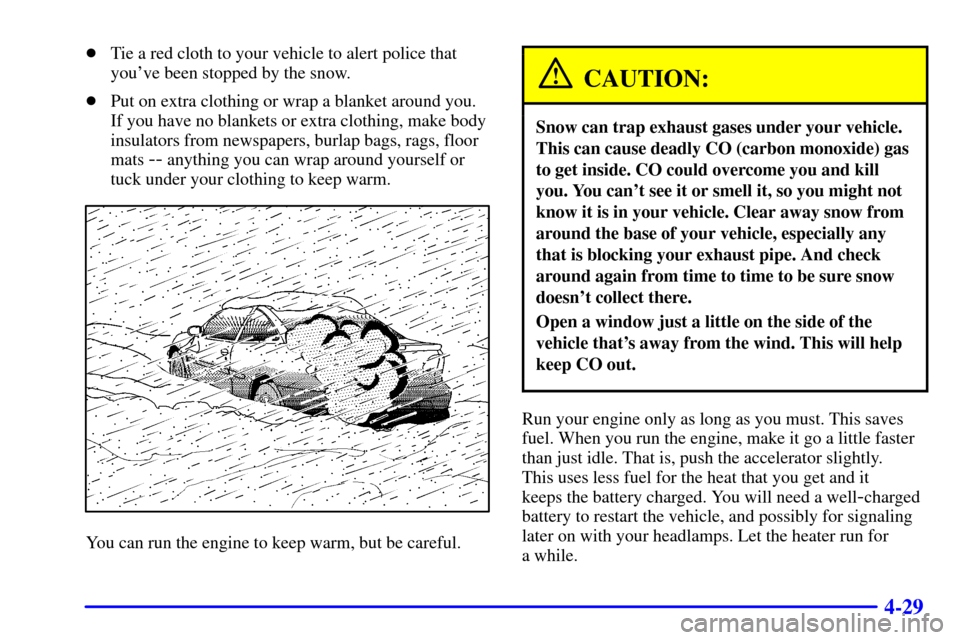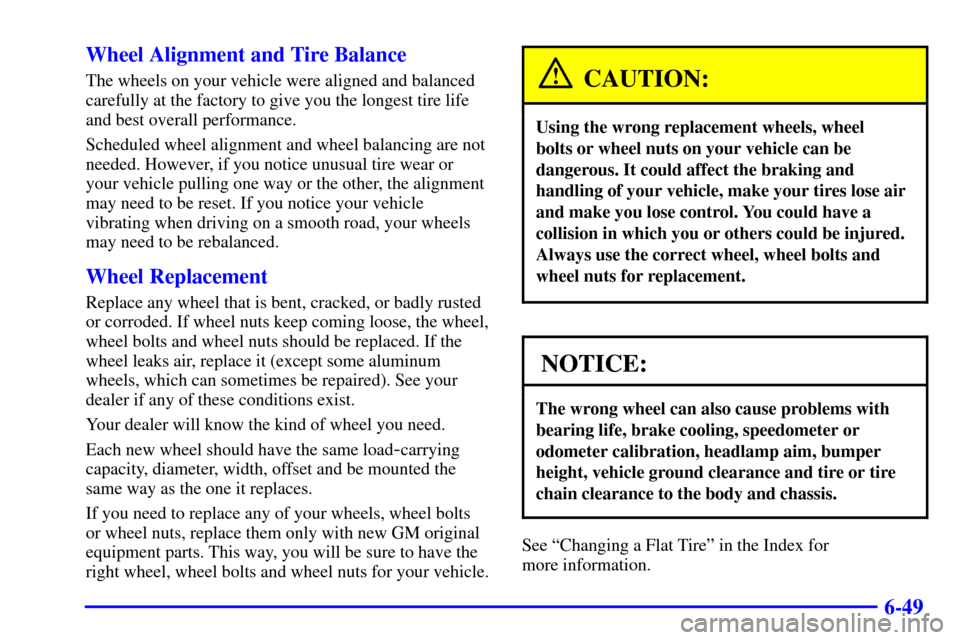Page 182 of 360

4-17
What you do in the daytime can also affect your night
vision. For example, if you spend the day in bright
sunshine you are wise to wear sunglasses. Your eyes
will have less trouble adjusting to night. But if you're
driving, don't wear sunglasses at night. They may cut
down on glare from headlamps, but they also make a lot
of things invisible.
You can be temporarily blinded by approaching
headlamps. It can take a second or two, or even
several seconds, for your eyes to readjust to the dark.
When you are faced with severe glare (as from a driver
who doesn't lower the high beams, or a vehicle with
misaimed headlamps), slow down a little. Avoid staring
directly into the approaching headlamps.Keep your windshield and all the glass on your vehicle
clean
-- inside and out. Glare at night is made much
worse by dirt on the glass. Even the inside of the glass
can build up a film caused by dust. Dirty glass makes
lights dazzle and flash more than clean glass would,
making the pupils of your eyes contract repeatedly.
Remember that your headlamps light up far less of a
roadway when you are in a turn or curve. Keep your
eyes moving; that way, it's easier to pick out dimly
lighted objects. Just as your headlamps should be
checked regularly for proper aim, so should your eyes
be examined regularly. Some drivers suffer from night
blindness
-- the inability to see in dim light -- and
aren't even aware of it.
Page 194 of 360

4-29
�Tie a red cloth to your vehicle to alert police that
you've been stopped by the snow.
�Put on extra clothing or wrap a blanket around you.
If you have no blankets or extra clothing, make body
insulators from newspapers, burlap bags, rags, floor
mats
-- anything you can wrap around yourself or
tuck under your clothing to keep warm.
You can run the engine to keep warm, but be careful.
CAUTION:
Snow can trap exhaust gases under your vehicle.
This can cause deadly CO (carbon monoxide) gas
to get inside. CO could overcome you and kill
you. You can't see it or smell it, so you might not
know it is in your vehicle. Clear away snow from
around the base of your vehicle, especially any
that is blocking your exhaust pipe. And check
around again from time to time to be sure snow
doesn't collect there.
Open a window just a little on the side of the
vehicle that's away from the wind. This will help
keep CO out.
Run your engine only as long as you must. This saves
fuel. When you run the engine, make it go a little faster
than just idle. That is, push the accelerator slightly.
This uses less fuel for the heat that you get and it
keeps the battery charged. You will need a well
-charged
battery to restart the vehicle, and possibly for signaling
later on with your headlamps. Let the heater run for
a while.
Page 275 of 360
6-36
Bulb Replacement
For the type of bulb to use, see ªReplacement Bulbsº in
the Index.
For any bulb changing procedure not listed in this
section, contact your dealer.
Halogen Bulbs
CAUTION:
Halogen bulbs have pressurized gas inside and
can burst if you drop or scratch the bulb. You or
others could be injured. Be sure to read and
follow the instructions on the bulb package.
Headlamps
To replace one of the headlamps, do the following:
1. Remove the seven plastic fasteners from the shield.
Use a screwdriver to pull up the center of the
fastener. Be careful not to break the fasteners that
hold the shield in place.
2. Remove the front park and turn signal lamp. Follow
Step 2 under ªFront Park and Turn Signal Lampsº
later in this section.
Page 276 of 360
6-37
3. Remove the two bolts from the headlamp assembly.
Pull the headlamp assembly up and toward the front
of the vehicle to access the bulb assembly.
4. Remove the black collar by turning it counterclockwise.5. Disconnect the bulb base from the socket by lifting
the plastic locking tab.
Page 277 of 360
6-38
6. Remove the bulb by pulling the bulb straight out.
7. Snap a new bulb into the socket.
8. Reinstall the bulb assembly by reversing
Steps 1 through 5, making sure the lower leg
of the headlamp bracket is properly seated into
the wedge
-shaped retainer.
Front Park and Turn Signal Lamps
1. Follow Step 1 under ªHeadlamps.º
2. Place the tip of a screwdriver through the rectangle
hole in the headlamp bracket. Apply pressure to the
snap feature (toward the outboard side of the
vehicle). Guide the lamp forward.
Page 278 of 360
6-39
3. When the lamp is removed twist the socket to
remove from the lamp. (The bulb is connected to
the wire harness).
4. Replace the bulb and reinstall the socket.5. Align the outboard pin to the outboard tab in the
bracket. Align the (two) inboard pins with the hole in
the headlamp bracket.
Page 279 of 360
6-40
6. Push the front park and turn signal lamp straight in
until you hear a snap. The snap feature is visible
through the slot in the headlamp bracket.
Taillamps and Rear Turn Signal Lamps
To replace a bulb, do the following:
1. Remove the fastener which holds down the trunk
trim. On vehicles without a convenience net, pry the
fastener loose. On vehicles with a convenience net,
remove the net and unscrew the fastener. Then pull
down the trunk trim.
2. Remove the assembly by turning it one
-quarter
turn counterclockwise.
Page 288 of 360

6-49 Wheel Alignment and Tire Balance
The wheels on your vehicle were aligned and balanced
carefully at the factory to give you the longest tire life
and best overall performance.
Scheduled wheel alignment and wheel balancing are not
needed. However, if you notice unusual tire wear or
your vehicle pulling one way or the other, the alignment
may need to be reset. If you notice your vehicle
vibrating when driving on a smooth road, your wheels
may need to be rebalanced.
Wheel Replacement
Replace any wheel that is bent, cracked, or badly rusted
or corroded. If wheel nuts keep coming loose, the wheel,
wheel bolts and wheel nuts should be replaced. If the
wheel leaks air, replace it (except some aluminum
wheels, which can sometimes be repaired). See your
dealer if any of these conditions exist.
Your dealer will know the kind of wheel you need.
Each new wheel should have the same load
-carrying
capacity, diameter, width, offset and be mounted the
same way as the one it replaces.
If you need to replace any of your wheels, wheel bolts
or wheel nuts, replace them only with new GM original
equipment parts. This way, you will be sure to have the
right wheel, wheel bolts and wheel nuts for your vehicle.
CAUTION:
Using the wrong replacement wheels, wheel
bolts or wheel nuts on your vehicle can be
dangerous. It could affect the braking and
handling of your vehicle, make your tires lose air
and make you lose control. You could have a
collision in which you or others could be injured.
Always use the correct wheel, wheel bolts and
wheel nuts for replacement.
NOTICE:
The wrong wheel can also cause problems with
bearing life, brake cooling, speedometer or
odometer calibration, headlamp aim, bumper
height, vehicle ground clearance and tire or tire
chain clearance to the body and chassis.
See ªChanging a Flat Tireº in the Index for
more information.